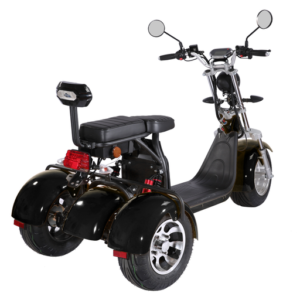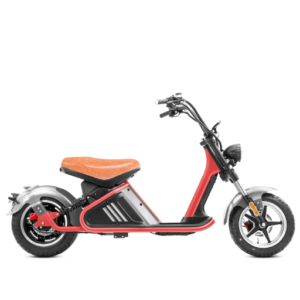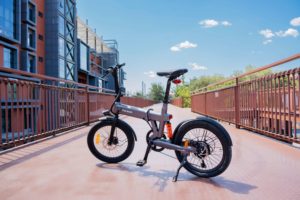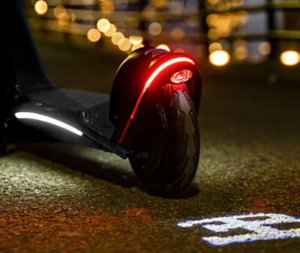The Rise of Electric Scooters in Urban Cities – Review
Eco-Friendly Commuting: The Rise of Electric Scooters in Urban Cities
Introduction: In recent years, the concept of eco-friendly commuting has gained significant momentum, and one of the key players in this movement is the rise of electric scooters in urban cities. As concerns about the environmental impact of traditional transportation methods grow, urban dwellers are seeking sustainable alternatives that promote zero emissions and contribute to greener living. This blog explores the changing face of urban mobility, focusing on the increasing popularity and benefits of electric scooters and other micromobility solutions. We’ll delve into the advantages of eco-friendly commuting, the impact of electric scooters in urban environments, and the evolving regulations and technological advancements driving this electric revolution.
Understanding the Environmental Challenges Posed by Traditional Commuting
Traditional commuting methods, primarily reliant on internal combustion engine vehicles, have a significant and detrimental impact on the environment. The combustion of fossil fuels in light passenger and commercial vehicles leads to the release of greenhouse gases (GHGs) into the atmosphere, contributing to global warming and climate change. The environmental challenges posed by traditional commuting are a growing concern, and addressing these issues is crucial for a sustainable and greener future.
Bugatti Electric Scooter Draw Here:
Ebikes Worth Mentioning Click Here
This site sponsors affiliate links which receive a commission on sales from our websites.
Greenhouse Gas Emissions from Light Passenger and Commercial Vehicles
One of the primary contributors to climate change in the U.S. is the transportation sector, specifically light passenger and commercial vehicles. According to the Inventory of U.S. Greenhouse Gas Emissions and Sinks 1990–2021, which is prepared annually under the United Nations Framework Convention on Climate Change, transportation accounted for the largest portion (29%) of total U.S. greenhouse gas (GHG) emissions in 2021. Cars, trucks, commercial aircraft, railroads, and other sources all contribute to the emissions from the transportation end-use sector.
In terms of GHG emissions from transportation sources, cars, trucks, and commercial aircraft play a significant role. These emissions primarily consist of carbon dioxide (CO2) and other greenhouse gases such as methane (CH4) and nitrous oxide (N2O). It is estimated that transportation emissions account for approximately 29% of the total greenhouse gas emissions in the USA, making it one of the largest contributors to anthropogenic emissions.
As the transportation sector continues to be a major source of greenhouse gas emissions in the USA, efforts to transition to more sustainable and low-emission alternatives are critical in combating climate change. Policy measures, technological advancements, and shifts towards electric and alternative fuel vehicles are some of the strategies being pursued to reduce the carbon footprint of the transportation sector and promote a more sustainable future.
Impact on Air Quality and Public Health
Aside from their contributions to climate change, traditional vehicles also have adverse effects on air quality and public health. The emissions from these vehicles contain particulate matter, nitrogen oxides (NOx), and volatile organic compounds (VOCs), which contribute to air pollution and smog formation. Prolonged exposure to such pollutants can lead to respiratory and cardiovascular issues, especially in urban areas with high traffic density.
Traffic Congestion and Urban Planning Challenges
The reliance on traditional commuting methods has also led to increased traffic congestion in urban centers. The growing number of vehicles on the roads results in longer commute times, decreased fuel efficiency, and higher energy consumption. Moreover, addressing traffic congestion requires substantial investments in infrastructure and urban planning to accommodate the growing demand for transportation.
Micromobility: The Future of Urban Commuting

Micromobility is a revolutionary concept that holds the key to transforming urban commuting and making it more sustainable. In essence, micromobility refers to a range of small, electric-powered vehicles designed for short-distance travel within urban environments. These vehicles include e-bikes, electric scooters, Segways, and similar devices, collectively known as personal mobility devices (PMDs) in road rules.
The Surging Popularity of Electric Bikes as a Green Alternative to Cars
Electric bikes, also known as e-bikes, have witnessed an unprecedented surge in popularity as an eco-friendly alternative to cars. The COVID-19 pandemic played a pivotal role in accelerating their adoption as people sought safe and independent transportation options. Countries like the Netherlands have witnessed e-bikes outselling traditional bicycles, signifying a growing preference for electrically assisted mobility. In fact, some predictions suggest that e-bikes may even outsell motor cars in Europe within the decade, signaling a significant shift towards greener commuting solutions.
The Legal Status and Adoption of Electric Scooters and Other PMDs in Different Regions
The legal status and use of electric scooters and other Personal Mobility Devices (PMDs) vary across different states in the USA. As electric scooters become a popular method of travel in cities across the country, each state has established its own set of regulations and laws governing their usage. These laws encompass various aspects, such as who can ride electric scooters, where they can be ridden, speed limits, helmets, and minimum age requirements.
Bugatti Electric Scooter Draw Here:
Ebikes Worth Mentioning Click Here
This site sponsors affiliate links which receive a commission on sales from our websites.
How Micromobility Addresses the Challenges of Urbanization and Limited Parking Spaces
Urbanization has led to a surge in population density within cities, leading to increased challenges related to traffic congestion and limited parking spaces. Traditional commuting methods exacerbate these issues, leading to longer commute times and higher energy consumption. Micromobility presents a viable solution to address these challenges by offering compact, agile, and energy-efficient vehicles suitable for navigating congested urban environments. Electric scooters, e-bikes, and other PMDs take up significantly less space than cars and are easily maneuverable, making them ideal for last-mile connectivity and short-distance trips.
Micromobility and Its Role in Sustainable Transportation
Micromobility is a revolutionary concept that holds the key to transforming urban commuting and making it more sustainable. In essence, micromobility refers to a range of small, electric-powered vehicles designed for short-distance travel within urban environments. These vehicles include e-bikes, electric scooters, Segways, and similar devices, collectively known as personal mobility devices (PMDs) in road rules.
The Surging Popularity of Electric Bikes as a Green Alternative to Cars
Electric bikes, also known as e-bikes, have witnessed an unprecedented surge in popularity as an eco-friendly alternative to cars. The COVID-19 pandemic played a pivotal role in accelerating their adoption as people sought safe and independent transportation options. Countries like the Netherlands have witnessed e-bikes outselling traditional bicycles, signifying a growing preference for electrically assisted mobility. In fact, some predictions suggest that e-bikes may even outsell motor cars in Europe within the decade, signaling a significant shift towards greener commuting solutions.
The Legal Status and Adoption of Electric Scooters and Other PMDs in Different Regions
Electric scooters and other Personal Mobility Devices (PMDs) have varying legal status and use across different states in the USA. Similar to Australia, where e-bikes are generally legal with certain limitations, the situation for electric scooters differs between states in the USA. For example, while electric scooters are allowed in some states like California and New York, they may be restricted or banned in others like Beverly Hills and West Hollywood.
The regulations for electric scooters in the USA are not always as straightforward and clear as they should be due to the relatively new technology and their increasing popularity. Each state has its own set of laws for micromobility vehicles, leading to confusion among riders regarding what rules to follow.
To provide some clarity, under the H.R. 727 amendment of the Consumer Product Safety Act, “low-speed bicycles” with certain specifications are considered legal. While no equivalent law exists specifically for electric scooters, they are generally accepted to fall under this category. As a result, electric scooters are allowed on roads with or without bicycle lanes, as long as they are running under 25 mph.
It’s important to be aware that each state enforces its own set of rules regarding electric scooter usage on public roads. For example, the greater Los Angeles area largely follows California’s motorized scooter law, which includes speed limits, helmet requirements, and restrictions on riding on sidewalks. On the other hand, New York City has recently legalized individual-owned electric scooters with certain speed and age restrictions, but shared electric scooters are still prohibited.
Major cities in the USA, such as Los Angeles, San Francisco, and Tampa, have well-established scooter-sharing services offered by companies like Lime, Bird, Uber Jump, and Lyft. These companies provide short-term rentals for their dockless scooters, allowing users to rent them for short durations and pay per minute of usage.
However, it’s essential for users to familiarize themselves with the specific laws and operating hours of electric scooters in the city they are in, as regulations and availability may vary from one location to another.
Overall, as electric scooters gain popularity and more individuals turn to these eco-friendly modes of transport, it becomes crucial for both riders and policymakers to work together to establish clear and consistent laws across different states, ensuring safer and smoother integration of electric scooters into daily transportation.
How Micromobility Addresses the Challenges of Urbanization and Limited Parking Spaces
Urbanization has led to a surge in population density within cities, leading to increased challenges related to traffic congestion and limited parking spaces. Traditional commuting methods exacerbate these issues, leading to longer commute times and higher energy consumption. Micromobility presents a viable solution to address these challenges by offering compact, agile, and energy-efficient vehicles suitable for navigating congested urban environments. Electric scooters, e-bikes, and other PMDs take up significantly less space than cars and are easily maneuverable, making them ideal for last-mile connectivity and short-distance trips.
The Electric Revolution: Advantages of Electric Scooters

Zero Emissions: Understanding the Environmental Benefits of Electric Scooters
Electric scooters stand out as a remarkable solution to combat the environmental impact of traditional transportation methods. One of the key advantages of electric scooters lies in their zero-emission nature, which significantly reduces greenhouse gas emissions and air pollution. Unlike combustion engine vehicles that emit harmful pollutants into the atmosphere, electric scooters are equipped with electric motors that are over three times more efficient. The energy required to propel an e-scooter is just a fraction of what a car or SUV demands, making them more than 1,000% more efficient per mile compared to average combustion vehicles. Even when powered by a grid reliant on fossil fuels, the emissions per mile from electricity generation remain negligible. By adopting electric scooters as a greener mode of transportation, urban cities can take a significant step towards mitigating the adverse environmental impacts of traditional commuting methods.
Bugatti Electric Scooter Draw Here:
Ebikes Worth Mentioning Click Here
This site sponsors affiliate links which receive a commission on sales from our websites.
Urban Mobility: How Electric Scooters Offer Convenient Transportation Solutions
Electric scooters present a revolutionary approach to urban mobility, offering a convenient and efficient transportation solution for short-distance trips within cities. These small-wheeled electric vehicles provide a more enjoyable and time-saving option for making short journeys. With the ease of renting and unlocking e-scooters using smartphone apps, riders can access them on-demand and cover the last-mile of their commutes seamlessly. Electric scooters also play a crucial role in reclaiming public space for bikes and increasing the usage of public transit. By integrating electric scooters into the existing mobility ecosystem, cities can enhance overall accessibility, reduce congestion, and promote a more interconnected transportation network.
Cost-Effectiveness and Reduced Congestion: The Economic Advantages of Electric Scooters
In addition to their environmental benefits, electric scooters offer compelling economic advantages. Compared to traditional cars, the cost of owning, maintaining, and operating electric scooters is significantly lower. The cost per mile for e-scooters is considerably reduced due to their energy-efficient electric motors. Furthermore, electric scooters play a pivotal role in reducing traffic congestion, especially in urban areas. With their nimble design and ability to navigate through traffic more easily, electric scooters alleviate the burden of congestion on roadways, leading to smoother traffic flow and faster commute times. Moreover, as more people opt for e-scooters for their daily commuting needs, the overall demand for limited parking spaces in crowded urban settings is alleviated.
Promoting Eco-Conscious Commuting: How Electric Scooters Fit into a Greener Lifestyle
Embracing electric scooters as a mode of urban commuting aligns with the principles of eco-conscious living. By choosing zero-emission transportation options like e-scooters, individuals actively contribute to reducing their carbon footprint and mitigating climate change. Electric scooters promote a greener lifestyle, fostering awareness of sustainable transportation choices. As riders experience the convenience and efficiency of electric scooters, they are encouraged to adopt environmentally friendly practices in other aspects of their lives. Additionally, the proliferation of electric scooters encourages cities to prioritize sustainable urban planning, leading to the development of greener infrastructure and policies.
Technological Advancements: Improving Battery Efficiency and Energy Density
Advancements in battery technology play a crucial role in the continuous improvement of electric scooters. Lithium-ion batteries, the preferred power source for electric scooters, have seen a remarkable reduction in cost and improvement in energy density over the years. The drop in battery prices and improvements in energy density allows for longer battery life and increased range for e-scooters, making them more viable for daily commuting needs. Technological innovations such as swappable batteries and improved battery management systems further enhance the efficiency and convenience of using electric scooters. As battery technology continues to evolve, electric scooters are poised to become even more efficient and accessible, further accelerating the electric revolution in urban commuting.
Micromobility emerges as a promising solution to revolutionize urban commuting and combat the environmental impact of traditional transportation methods. The growing popularity of electric bikes and other PMDs signifies a shift towards more sustainable and eco-friendly transportation choices. As governments and urban planners recognize the benefits of micromobility in reducing greenhouse gas emissions, tackling congestion, and enhancing urban mobility, we can expect to see further advancements and adoption of these green transportation options. By embracing micromobility, urban cities can pave the way for a greener and more sustainable future of urban commuting.
FAQs: The Future of Micromobility and Urban Transportation

- How do electric scooters contribute to reducing greenhouse gas emissions?Electric scooters are over three times more energy-efficient than traditional combustion engine vehicles, making them a cleaner and greener mode of transportation. They produce zero tailpipe emissions, thereby reducing the carbon footprint and helping combat climate change.
- Are electric scooters legal in all regions?The legal status of electric scooters varies across different regions and countries. While some areas have embraced electric scooters and integrated them into their transportation systems, others may have specific regulations or restrictions in place. It’s essential to check local laws and regulations before using electric scooters.
- How does micromobility address the challenges of urbanization and limited parking spaces?Micromobility, including electric scooters and e-bikes, provides a solution to the challenges posed by urbanization and limited parking spaces. With their compact size and efficient energy use, electric scooters offer a convenient and flexible alternative for short-distance commutes, reducing the need for larger vehicles and parking spaces.
- What role do regulatory bodies play in shaping the micromobility landscape?Regulatory bodies play a crucial role in establishing guidelines and standards for the safe integration of electric scooters and other PMDs into urban transportation. They work in collaboration with city officials and micromobility providers to ensure safety, efficiency, and compliance with local laws.
- How can electric scooters help reduce traffic congestion in cities?Electric scooters can help reduce traffic congestion by offering a viable alternative to private car usage for short-distance trips. With more people opting for electric scooters, the overall volume of cars on the roads decreases, leading to smoother traffic flow and less congestion.
- What are some technological advancements driving the future of micromobility?Technological innovations in the micromobility sector include the development of electric scooters with longer battery life, swappable batteries, improved energy density, and innovative designs like Walkcars and electric unicycles. These advancements contribute to enhanced efficiency and accessibility of micromobility solutions.
- How can micromobility contribute to promoting sustainable urban living?Micromobility supports sustainable urban living by reducing greenhouse gas emissions, air pollution, and noise levels. By providing eco-friendly transportation options, micromobility encourages a shift towards greener lifestyles, promoting environmental consciousness and sustainable city living.
- Will electric scooters replace other modes of transportation entirely?While electric scooters have gained popularity as a convenient urban transportation option, they are not likely to replace other modes of transportation entirely. Instead, they complement existing transportation systems, filling the gap for short-distance commutes and providing an eco-friendly alternative to cars.
- How do shared scooter trials contribute to the future of micromobility?Shared scooter trials serve as valuable testing grounds to assess the feasibility and impact of electric scooters on urban transportation. The data and feedback collected from these trials help inform future policies and decisions regarding the integration of electric scooters into cities.
- Can micromobility revolutionize the way we view public space allocation?Yes, micromobility can revolutionize public space allocation by advocating for a reallocation of space towards protected bike and scooter lanes, wider sidewalks, and improved public transit infrastructure. By promoting a more efficient use of public space, micromobility contributes to enhanced livability and congestion reduction in urban areas.
WARNING:

Before you go Enter the Draw for the Bugatti Electric Scooter Draw Here:
Ebikes Worth Mentioning Click Here
Back to Top
To use our purchasing process you must be 18 years of age or older to purchase any product on our website and not represent or purchase on behalf of anyone under this age as set at the point of purchase. The scooter will be registered on our database to the Name and Address etc of the purchaser.
This post or page may contain affiliate links that may earn a small commission at no additional cost to you. I use affiliate links because they allow me to share useful products and services with you that are related to the topic of my website. Affiliate links also help me earn some income from my website, which enables me to keep creating high-quality content for you. I appreciate your support and trust!
- Health Benefits of Electric Bikes
- What to Look for When Buying an E-bike
- Best Electric eBikes for Your Little One
- How to Safely Unlock the Top Speed on Unagi Electric Scooters
- Breaking: The Shocking Truth About E Scooter Laws in WA!
- Can You Ride Scooters On The Road “California”
- Can Electric Scooters Get Wet? Yes!
- How do I transport my electric scooter in a car?
- Top 6 Long Range Electric Scooters
- Two-Stroke or Four-Stroke? Gas Scooter Showdown

